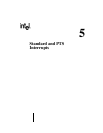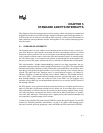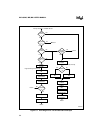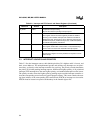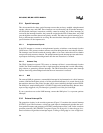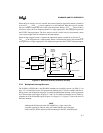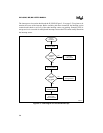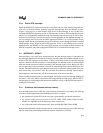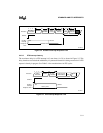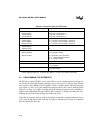
8XC196MC, MD, MH USER’S MANUAL
5-6
5.3.1 Special Interrupts
This microcontroller has three special interrupt sources that are always enabled: unimplemented
opcode, software trap, and NMI. These interrupts are not affected by the EI (enable interrupts)
and DI (disable interrupts) instructions, and they cannot be masked. All of these interrupts are
serviced by the interrupt controller; they cannot be assigned to the PTS. Of these three, only NMI
goes through the transition detector and priority encoder. The other two special interrupts go di-
rectly to the interrupt controller for servicing. Be aware that these interrupts are often assigned to
special functions in development tools.
5.3.1.1 Unimplemented Opcode
If the CPU attempts to execute an unimplemented opcode, an indirect vector through location
2012H occurs. This prevents random software execution during hardware and software failures.
The interrupt vector should contain the starting address of an error routine that will not further
corrupt an already erroneous situation. The unimplemented opcode interrupt prevents other inter-
rupt requests from being acknowledged until after the next instruction is executed.
5.3.1.2 Software Trap
The TRAP instruction (opcode F7H) causes an interrupt call that is vectored through location
2010H. The TRAP instruction provides a single-instruction interrupt that is useful when debug-
ging software or generating software interrupts. The TRAP instruction prevents other interrupt
requests from being acknowledged until after the next instruction is executed.
5.3.1.3 NMI
The external NMI pin generates a nonmaskable interrupt for implementation of critical interrupt
routines. NMI has the highest priority of all the prioritized interrupts. It is passed directly from
the transition detector to the priority encoder, and it vectors indirectly through location 203EH.
The NMI pin is sampled during phase 2 (CLKOUT high) and is latched internally. Because inter-
rupts are edge-triggered, only one interrupt is generated, even if the pin is held high.
If your system does not use the NMI interrupt, connect the NMI pin to V
SS
to prevent spurious
interrupts.
5.3.2 External Interrupt Pin
The protection circuitry in the waveform generator (Figure 5-2) monitors the external interrupt
(EXTINT) signal. When it detects a valid event on the input, it sumultaneously disables the wave-
form generator outputs and generates an EXTINT interrupt request. Bits 2 and 3 in the waveform
generator protection (WG_PROTECT) register (Figure 9-9 on page 9-15) select the type of ex-
ternal event that will generate an interrupt request: a falling or rising edge or a low or high level.




